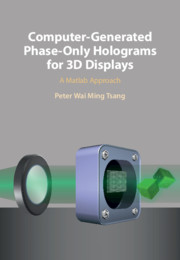Book contents
- Computer-Generated Phase-Only Holograms for 3D Displays
- Computer-Generated Phase-Only Holograms for 3D Displays
- Copyright page
- Contents
- Preface
- Acknowledgments
- 1 Introduction to Digital Holography
- 2 Fast Methods for Computer-Generated Holography
- 3 Generation of Phase-Only Fresnel Hologram
- 4 Conversion of Complex-Valued Holograms to Phase-Only Holograms
- 5 Applications of Phase-Only Hologram in Display, Holographic Encryption, and Steganography
- Index
- References
1 - Introduction to Digital Holography
Published online by Cambridge University Press: 07 January 2021
- Computer-Generated Phase-Only Holograms for 3D Displays
- Computer-Generated Phase-Only Holograms for 3D Displays
- Copyright page
- Contents
- Preface
- Acknowledgments
- 1 Introduction to Digital Holography
- 2 Fast Methods for Computer-Generated Holography
- 3 Generation of Phase-Only Fresnel Hologram
- 4 Conversion of Complex-Valued Holograms to Phase-Only Holograms
- 5 Applications of Phase-Only Hologram in Display, Holographic Encryption, and Steganography
- Index
- References
Summary
The fundamental principles of optical holography for capturing the optical waves of physical objects, and its difference from photography, are described. A photograph can only record a single view of an object scene; a hologram is capable of capturing the entire optical wavefront that impinges on it. There should be little difference between observing a hologram and the physical object scene. Numerical generation of digital holograms, commonly known as computer-generated holography (CGH), is presented. Two important approaches in CGH, the point-based and the layer-based methods, are described. The point-based method is suitable for generating holograms of simple objects with a small number of object points; the layer-based method is preferred for an object scene with a large number of object points concentrated in a few depth planes. The method for recovering a 3-D scene image from a digital hologram is provided. Three different methods for capturing digital holograms of physical object scene are described. The first method is similar to the art of optical holography, but instead of a photographic film, a digital camera is used to record the holographic waves emitted from the scene. As a digital camera can only record intensity information, the method can only be employed to capture an off-axis, amplitude-only hologram. The other two methods, known as phase-shifting holography (PSH) and optical scanning holography (OSH), are capable of capturing both the magnitude and phase components of the holographic signals. PSH is faster in operation, while OSH can be used to capture holograms of large objects. A simplified version of OSH, known as non-diffractive optical scanning holography (ND-OSH), is presented. ND-OSH is similar in principle to OSH, but the complexity of the optical and electronic setups is reduced.
Keywords
- Type
- Chapter
- Information
- Computer-Generated Phase-Only Holograms for 3D DisplaysA Matlab Approach, pp. 1 - 39Publisher: Cambridge University PressPrint publication year: 2021

